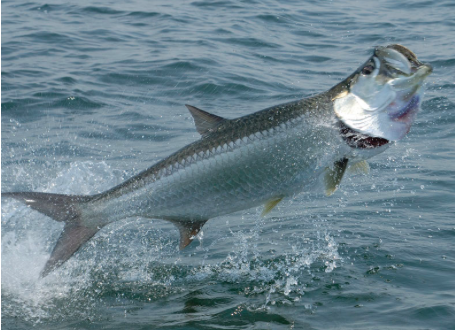“The Silver King”

People from all around the world come to Florida to catch fish. People native to Florida have come up with the name “Game Fish” for the most sought after species.. Game Fish, mostly referring to Snook, Tarpon and Redfish, are the reason many people are so excited and spend thousands of dollars to come to Florida and fish.
The most sought after catch-and-release fish is the Tarpon. The Tarpon is also referred to as “The Silver King” and “Poon.” They are known as the king of the ocean because of their size and color. Tarpon fossils trace back to as long as 125 million years ago which also shows scientists that when tarpon are in their larval stage, they are transparent and have a ribbon-like body and prominent fang-like teeth, and are less than an inch long. Surprisingly, tarpon are also related to the bonefish, ladyfish and the eel. It is surprising to most people since the tarpon is a much bigger fish than the bonefish, ladyfish and eel which typically only get from 1-3 feet long.
Tarpon have evolved over many years to have more stamina, strength and even live and grow longer. This is another reason why the tarpon is one of Florida’s premier game fish. When you hook into one (even the juveniles) these fish will put on a show comparable to the SeaWorld Dolphin Show. This makes the tarpon one of the hardest fish to catch in the world. Not to mention the fact that you have to be at the right place at the right time.They are only around the more southern parts of Florida from the spring time towards the end of summer. This is a because of their mating season and the mullet run. In the fall and winter, tarpon go around the Texas and Mexico area since the water and climate stays warm.
How to Catch Tarpon
You can catch tarpon in many areas such as bridges, beaches and docks. Also, wherever there is warm water. That tends to be around 10-60 feet deep and there are plenty of food sources available for tarpon there… In deeper water, tarpon have less places to break your line, and will not have as much energy because of the pressure in the deeper water column. It makes them much easier to hook and land rather than in the bridges or docks where tarpon have many places where they can break your line.
Tarpon are one of the many game-fish that are picky with what they eat. If you think a fish that can get up to 9 feet long and 350 pounds would eat anything that they could, you are very wrong. Their diet mostly includes blue crabs, mullet, pinfish, sardines, and shrimp.Smaller freshwater tarpon will eat worms, insects and grass shrimp. If you get lucky, they may even bite a soft plastic lure, some from the brands Hogy, D.O.A, and Livetarget that make plastic swimbaits and topwaters that look like real fish.
Tarpon are also very “leader shy.” This means that if they can see your line, they will not even think about eating eating your bait. The recommended line that I mostly use for tarpon is 40-80 pound braid and 80-150 pound monofilament depending on the size you are going after. In order to not break your line or pull your hook out of their mouth, you must also use a 9-10 size circle hook. The reason for such heavy line is if the tarpon goes into docks or bridge pilings then you have enough abrasion resistance and you have a greater chance of it not breaking off.
Reeling in
Once you hook into a Tarpon, get ready! The second that they feel the hook, they will jump up to 20 feet, which is one of the most astonishing things you will witness. You may be in awe, but you must “bow to the King,” often a fitting symbol of who is in charge of the situation. In order to “bow” correctly, lean forwards, still holding your rod tightly and allow there to be a good amount of slack in your line. If done incorrectly, the hook will most likely fall out of its mouth, making you lose the fish of a lifetime.
You should also make sure you don’t fight a tarpon for too long or there is a good chance that they will die due to fighting to exhaustion similar to the Hammerhead shark. When you finally have a hold of your tarpon, if it is larger than 40 inches, it is illegal to bring out of the water. You will need to safely take the hook out, take a picture quickly and release it as soon as possible to increase the chances of it surviving.
All Tarpon are illegal to keep and if you decide to keep one anyway, it is up to a 500 dollar fine and you could get your fishing license taken away forever. If you are fishing safely for the fish and also for yourself, doing it legally and using the right gear, you will have fun catching some big fish and remember to keep your lines tight.
Your donation will help support not only the student Journalism and Yearbook clubs at Marco Island Academy, but as well as any new equipment, club improvements, and annual website hosting costs.

Noah Blaskovich is a 15 year old freshman and a staff writer for The Wave. In his free time, he watches videos on the process and details of fixing different...


